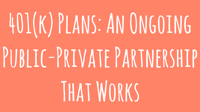 The observance of National 401(k) Day on Friday, September 9th is an opportunity to reflect on the long-running, highly successful public-private collaboration that has fostered the rapid ascendance of America’s 401(k) system.
The observance of National 401(k) Day on Friday, September 9th is an opportunity to reflect on the long-running, highly successful public-private collaboration that has fostered the rapid ascendance of America’s 401(k) system.
It’s my belief that this partnership will continue to drive innovations that will expand and improve the 401(k) system for millions of Americans – not only helping them to save more but preserving more of their savings for retirement.
Rapid Innovation
If judged by our frenetic news cycle, the pace of 401(k) innovation can feel glacial by comparison. However, the history of 401(k) plans tells a different story.
In 1978, Congress passed the Revenue Act of 1978, which included provision 401(k), allowing employees to defer taxation from bonuses and stock options. The general intent of the provision was to limit executive compensation – not to spawn a ubiquitous retirement savings vehicle.
The private sector, including legendary trailblazer Ted Benna, along with several large corporations, seized the moment, seeing opportunity in using employee salary reductions as a source of tax-deferred retirement plan contributions. With an assist from the IRS in 1981, the first so-called 401(k) plans began operating in January 1982.
The subsequent growth in 401(k) plans was stunning. By 1984, the U.S. Department of Labor (DOL) reported 17,303 plans, with 7.53 million active participants, and that was only the beginning.
The Public-Private Partnership
While the initial role of policymakers in facilitating 401(k) plans was accidental, follow-on policies were more intentional, seeking to rein in abuses (ex. – non-discrimination testing rules) and to prevent highly-compensated employees from dodging taxes.
Far from constraining the growth of 401(k) plans, these actions and many others produced more private sector clarity and confidence, fueling greater expansion. Only twelve years later, in 1996, there were 230,808 401(k) type plans with over 30 million participants, holding retirement assets of $1.06 trillion.
Let that sink in for a second. In little over a decade, an entirely voluntary, private sector-based ecosystem of retirement plan sponsors, recordkeepers, fund managers and consultants had coalesced around an “accident” of public policy – and were successfully partnering with policymakers to fuel its rapid growth.
But the best was yet to come.
The Rise of the Automatics
For millions of employees, simply providing them with a voluntary option to participate in an employer-sponsored qualified retirement plan was all they needed. However, the private sector realized that not all employees were predisposed to virtuous savings behaviors, and that many require helpful “nudges” to act in their long-term self-interest.
In 1998 and 2000, the IRS issued two rulings that provided guidance on “negative elections” – which eventually gave rise to auto-enrollment and auto-escalation, two features which, at the discretion of the plan sponsor, transformed participants’ best choices into the default, easiest ones.
Building on this, The Pension Protection Act of 2006, among many other things, granted sponsors a safe harbor for auto enrollment and auto escalation and incorporated acceptable standards for Qualified Default Investment Alternatives (QDIAs), including the use of target date funds, to protect them from losses by employees who were automatically enrolled. These target date funds had the added benefit of simplifying investment decisions and promoting savings diversification.
By 2010, there were 518,675 401(k) plans with 60.5 million participants, housing $3.14 trillion of retirement savings. By 2019, the torrid pace of 401(k) plan growth had slowed somewhat, reaching 604,424 plans, but total 401(k) assets doubled, reaching $6.24 trillion.
What to Do for an Encore?
Expanding access to 401(k) plans, providing targeted tax incentives to savers, and simplifying 401(k) plan administration for plan sponsors represent the continuation of past themes that have moved the needle for 401(k) system growth.
While actions that fill the 401(k) savings bucket typically get the most attention, innovations are being advanced that will also plug the bucket’s leaks, including measures that make the 401(k) system more efficient and sustainable by curbing cashout leakage and providing for emergency savings. The demographic segments hit hardest by cashout leakage are those that can least afford it, including minorities, lower-income workers, and younger age segments – all of whom cash out at much higher levels than their counterparts.
As a result, a powerful public-private partnership has formed behind auto portability, which is revolutionizing and automating the transfer of small balances left behind by job-changing participants.
- The concept of auto portability and its foundational technology originated within the private sector.
- In 2018-2019, the DOL promulgated a regulatory framework for auto portability that encouraged its adoption by recordkeepers and plan sponsors.
- Auto portability has been embraced by two large recordkeepers, with more on the way.
- Two premier civil rights organizations – the NAACP and the National Urban League – have publicly stated their support for auto portability.
- Research by the Employee Benefits Research Institute (EBRI) confirms that auto portability is sound public policy – whether evaluated as a standalone initiative or in tandem with other policy initiatives.
- Most recently, on 6/22/22, the U.S. Senate included bipartisan support for auto portability in their version of a SECURE 2.0 bill, the Enhancing American Retirement Now (EARN) Act.
If past is prologue, then auto portability could soon be supported by enabling legislation, adopted by a growing network of recordkeepers and plan sponsors, and quickly become a ubiquitous feature in most 401(k) plans – providing yet another example of public-private collaboration that has proven to be so successful in the past.

 1916 Ayrsley Town Boulevard
1916 Ayrsley Town Boulevard